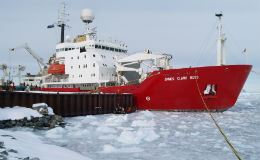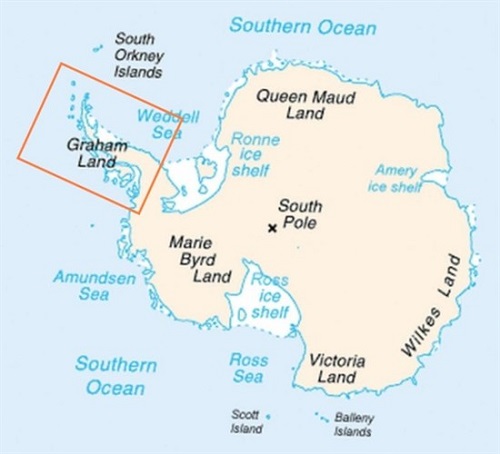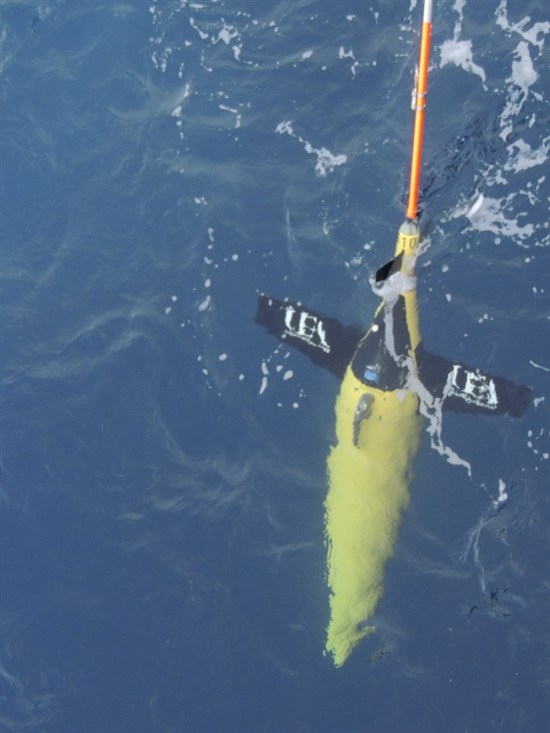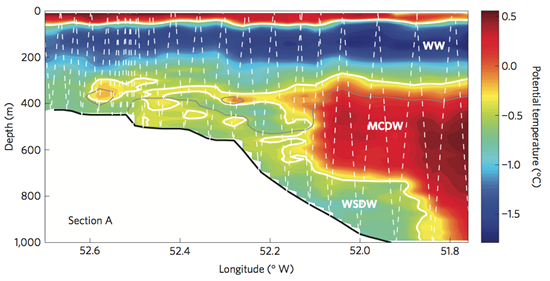Remote-control robots reveal why the Antarctic ice sheet is melting
Posted on 12 November 2014 by Guest Author
This article was originally posted on The Carbon Brief on Nov 10, 2014
by Robert McSweeney

At current rates, ice sheet loss will become the most significant contributor to global sea level rise during this century, yet there is still a lot that scientists don't know about the underlying causes. This is partly because Antarctica is such a difficult place to take measurements.
But now robotic underwater gliders are giving scientists new insight into why the Antarctic ice sheet is melting.
Ice sheets
An ice sheet is a huge layer of ice that sits on land. The two on the Earth today are found on Antarctica and Greenland, but in the last ice age there were also ice sheets on North America and northern Europe.
The Antarctic ice sheet spans more than 14 million square kilometers, which is roughly the same size as the US and Mexico put together. The ice sheet also spills out onto the surrounding ocean in the form of ice shelves.
The Intergovernmental Panel on Climate Change (IPCC) estimates that the Antarctic ice sheet is currently losing around 150 billion tonnes of ice per year. One of the main areas of ice loss is from the Antarctic Peninsula, shown in the red rectangle in the map below.

Map of Antarctica. Antarctic Peninsula shown in red rectangle. Creative Commons.
This loss of ice isn't caused by melting on the surface of the ice sheet, as even summer temperatures in Antarctica tend to be below zero degrees,
Instead, loss of Antarctic ice is largely caused by warm water at the coast melting the edges of the ice sheet.
But what scientists have found difficult to explain is how warm water, which is usually hundreds of metres deep in the Southern Ocean, reaches the shallower waters of the Antarctic coast in order to melt the ice sheet.
A new study, published in Nature Geoscience, shows how underwater robots are helping scientists to find the answer.
Underwater gliders
Scientists deployed three robotic underwater gliders in the Weddell Sea, near the Antarctic Peninsula. They sent them on over 750 dives of up to 1,000 metres deep, controlling them remotely from over 10,000 miles away at the University of East Anglia in Norwich.

Robotic underwater glider. Thompson et al. ( 2014)
The gliders take measurements of temperature, oxygen and salinity at a range of depths. This allows the scientists to build up a profile of the temperature variations in the ocean around the Antarctic coast.
The warm water of the deep ocean is shown as reds and oranges on the right-hand side of the cross-section below. You can see the warmer water stretching out as yellow and orange blobs of heat towards the shallower water on the coast to the left.
Their results showed that this warm salty water is being transported towards the coast by swirling underwater currents known as 'eddies'.

Temperature profile along a cross-section in the northwestern Weddell Sea on the coast of the Antarctic Peninsula. The shallower, coastal waters are on the left, and the deeper ocean on the right. The white section shows the seabed, part of the Antarctic land mass. The white dotted lines show the paths of the robot gliders when taking readings. Thompson et al. ( 2014)
Losing mass
Understanding how the ice sheet is melting is important for scientists to make projections of what effect it will have on global sea levels.
As co-author, Professor Karen Heywood, says in the press release:
"Our research reveals the process by which warm water is being transported towards the ice. It is important because the rapidly melting ice sheets on the coast of West Antarctica are a potential major contributor to rising ocean levels worldwide."
In its recent synthesis report, the IPCC says there is "high confidence" that the Antarctic ice sheet has been losing mass over the past two decades. It also says that it is "likely" that the loss of ice has sped up in the last decade.
While changes in the Antarctic ice sheet are only projected to contribute around 5cm to sea levels by the end of the century, the IPCC says that it could contribute "several tenths of a metre" if ice loss accelerates.
The researchers hope that their robot gliders will help them make further advances in understanding what is happening in the Antarctic. As Prof Heywood puts it:
"The results have identified ocean features that could not feasibly have been studied by any other means. The use of ocean gliders is beginning to revolutionise our understanding of polar ocean processes."
Thompson, A.F. et al. (2014) Eddy transport as a key component of the Antarctic overturning circulation, Nature geoscience, doi:10.1038/ngeo2289































 Arguments
Arguments






























Greeeeat! (not)
So another reason why melting may happen even faster than we thought. It seems as though there have been a number of these lately. Is anyone putting them all together to determine how much more slr we should expect in the coming decades once these newly discovered mechanisms are figured in?
wili... Is this research showing increased loss? Or is it merely showing the mechanisms at play in measured and projected ice loss?
"This loss of ice isn't caused by melting on the surface of the ice sheet, as even summer temperatures in Antarctica tend to be below zero degrees."
True, though I do think surface temps get close to 0°C on the Antarctic Peninsula during summer. (And sunshine can override such temperatures to induce melting, though I don't know how cloudy that region is in the summer.) So what could also be important is the potential for those temps to rise above freezing in the summer with future warming, and whether that would be enough to drive a lot more ice melt. What does the research have to say on this?
"Instead, loss of Antarctic ice is largely caused by warm water at the coast melting the edges of the ice sheet."
I would think the most vulnerable ice would be the ice shelves, not the ice sheet itself. Much of Antarctica’s coastline, including the Antarctic Peninsula, is buffered by ice shelves. Should we be concerned with melting ice sheets on those coastlines, or primarily just coastlines where there is no ice shelf? (It appears the robots covered the northern tip of the Antarctic Peninsula — around 63°N. So in that case, there isn’t an ice shelf present.)
But even if ice shelves can protect the ice sheet from the warmer water, I do see how this could have big implications down the road for coastlines that are buffered by an ice shelf. If the ice shelf melts, the coastline could become vulnerable to the water.
DAK @3
The Antarctic ice shelves are and for all the time we've known them have been largely seasonal, the minimum area being about about 3 million km2 and the maximum area some 18 million km2.
I don't believe it matters whether the sea ice is present or not where the warm water eddies are concerned. If anything, I'd guess the sea ice might cause more heat to reach the ice sheet. To me, the system looks like a roiling lava lamp.
Don @4
It's true that much of the sea ice around Anarctica isn't permanent (a point often overlooked by climate contrarians). And granted, much of Antarctica's coastline is (or almost is) ice-free in summer. But a significant portion of the Antarctic Peninsula's coast seems to have ice shelves.
I do take your point on the ice shelve's role being minor in how warm water may reach the surface. I'd appreciate if someone could further explain or refer to what role (if any) sea ice plays in warm water reaching the surface and affecting the coastline.
Don, I think you are confusing the seaice with permanent ice shelves like the Ross and Ronne which are certainly not seasonal.
DAK, I think you can regard the ice shelves as the edges of ice sheets in terms of the article. Losses translate into faster rates of movments in the icesheets.